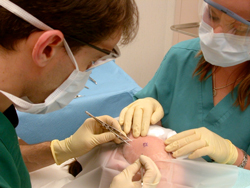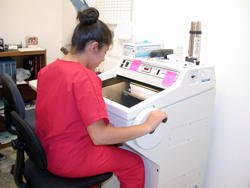What is Mohs Surgery?
Named after the surgeon who pioneered the procedure in the 1930's, Mohs Surgery is a specialized procedure used to treat skin cancers by removing the cancer layer by layer. The purpose of Mohs Surgery is to remove the least amount of tissue with the highest possible cure rate. It is performed in an outpatient clinic under local anaesthesia.
Why Mohs Surgery?
Many skin cancers are often described as having "roots" that extend beyond the apparent borders of the tumor. By using the Mohs Surgery technique, the borders or margins of the tumor are checked to remove these "roots". This allows for a higher cure rate than other techniques. Mohs Surgery has a cure rate that approaches 99% for primary (never treated) basal cell carcinomas and 95% for recurrent tumors.
Is Mohs Surgery right for me?
If this is your first time having Mohs Surgery, our doctors would like to meet with you prior to having the procedure done. This will allow our doctors to examine your skin cancer, obtain a medical history and determine whether the technique of Mohs Surgery would be the best treatment for your skin cancer. It will also allow you to learn about the procedure and ask any questions that you may have.
How to Prepare For Mohs Surgery
Be sure to take all your regularly scheduled physician prescribed medications. If you are on blood thinners, our doctors can discuss with you the risks and benefits of taking these medications.
The main thing to prepare for with Mohs Surgery is a full day long procedure and spending most of the day waiting for slide results. As such, you should bring food to eat and something to read or entertain yourself.
Note that if your wound repair following Mohs Surgery is scheduled with an outside surgical specialist, it is possible they may have advised you not to eat prior to their procedure.
What to Expect on the Day of Mohs Surgery
Our nurses will bring you to our surgical suite. Together, we will identify and confirm with you the locations of the tumors. Next, the area is numbed around the tumor using local anaesthesia to eliminate pain. This usually stings for a few seconds and is usually the only pain felt throughout the whole procedure.
The visible portion of the tumor is then carefully removed using a scalpel or curette.
The next step involves removal of a layer of tissue to check the margins for presence of tumor. A 1-3mm margin around the tumor is drawn and a thin pancake-shaped piece of tissue is removed using a sharp scalpel.

We then bring this tissue to the laboratory, process this tissue and make slides. This slide making process may take several hours and during this time, a bandage is placed on your wound and you may be brought to the waiting room area to await the results.

When the slides are ready, our doctors then examine both the lateral and deep margins of the tissue with a microscope and checks for tumor. The results of this step are plotted on a map of the treatment area.

If there is any tumor left in any section, you are brought back to the surgery room, and another tissue layer is taken, to again check the margins for tumor. This process is repeated until the base and sides of the tumor no longer contain tumor cells and the cancer is totally removed. It usually takes most patients 2-3 stages to clear a tumor, with each stage taking approximately 2-3 hours. Occasionally, it can take 4-5 or more stages to clear the tumor. Sometimes, but rarely, we are not able to complete clearing the tumor in one day and may have you come back the following day to continue the Mohs Surgery procedure.
Once the surgery is complete, our nurses will give you written and verbal instructions on how to care for your wound. If prescriptions for antibiotics or pain medications are indicated, you will receive them at this time.
Repair Surgery
Once the tumor is removed, you are left with a surgical wound. our doctors will discuss the repair options with you and make recommendations on the option that will achieve the best cosmetic and functional result. These options may include:
- Natural Healing: In certain areas of the face and body, wounds heal better when left to heal naturally. Wounds healing on their own may take a month or more to fill in and you may need to change the bandages regularly during this time.
- Closing with stitches: This involves pulling the wound edges together and closing the wound with surgical stitches. If this option is recommended to you, then the stitching usually takes approximately 1-2 hours to complete. You will need to return to have the stitches removed, which is usually 1 week on the face and 1 week on other parts of the body.
- Skin Graft: This option involves taking skin from another part of the body and stitching it into place to close the wound. You should not get the skin graft wet during this time. It may be recommended that you bathe using a sponge bath during this week. The stitches on the skin graft usually need to be removed in 1 week.
- Skin Flap: This process involves surgically cutting and pulling skin from an area adjacent to the wound and stitching it in place. Usually you will need to return in 1 week to have the stitches taken out. Sometimes skin flaps may require a second stage or additional surgery to complete which may be in 2-3 weeks.
- Consultation with Another Surgical Specialist: Our doctors may recommend that you see another surgical specialist to discuss repairing the surgical wound after Mohs Surgery. They may require that you meet with them in consultation prior to surgery. Our office will make arrangements with the other surgical specialist's offices to arrange your surgery dates. You may be having surgery with the specialist on the same day or several days after your Mohs Surgery procedure. Sometimes the surgical specialist will require that you do not eat the day of the surgery if your repair will be done in a hospital operating room and require general anaesthesia.
After Mohs Surgery
Healing and wound care will be explained in depth to you following Mohs Surgery. In general, wounds tend to heal better when covered with ointment and a bandage. We usually recommend the use of plain vaseline as a covering ointment to be applied 1-2 times per day.
It is common to experience mild pain for several days following the Mohs Surgery procedure. Usually over-the-counter Tylenol (acetaminophen) taken at recommended doses is enough to relieve the pain. If you are still having pain, please contact our office so we can evaluate your symptoms.
It is also common to feel fatigue for 1-2 days following Mohs Surgery and most people elect to rest and not work during this time.
Look for signs of infection including tenderness, warmth, fever, and pus at the wound site. If you notice these or other signs, please contact our office immediately.
It is important to make an appointment and see your referring dermatologist or physician for a complete skin check 3-6 months after completion of the Mohs Surgery. Regular skin surveillance is critical for early detection and prevention of skin cancer.

